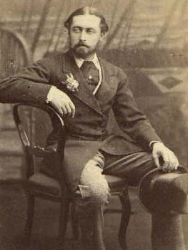The Duke of Edinburgh - Hero or Villain?
|
Queen Victoria gave her second son, Albert, the title of Duke of Edinburgh. Albert entered the Navy at his own request beginning service as a Midshipman in 1856 rising to C in C Devonport in 1890 after active service throughout the world. Although no doubt some of the reason for promotion was related to his parentage he appears to have been highly regarded as a seaman by his naval colleagues. He left the Navy in 1893 when he inherited the Title Duke of Saxe-Coburg and Gotha and moved to Germany.
Albert Duke of Edinburgh Photo courtesy of wikimedia commons The events of 15 November 1882 Albert was a Vice Admiral in the Navy having just returned from a lengthy posting in Malta. The following year he was to be made C in C of the British Fleet in the Channel. As befitting his rank as Admiral a naval vessel - Steam yacht Lively was at his disposal for use with both Naval and Royal duties. On 15 November 1882 Albert embarked on the Lively to sail to Harwich where he was to inspect the Coastguard Station and HMS Penelope which was the Harwich coastguard ship. On his way to Harwich Lively came across a steamer that signalled distress. On inspection it transpired that the steamer had run out of coal and was forced to anchor near to the dangerous Maplin Sands. Lively made full speed to Harwich where the situation was reported to the Coastguard and supplied were dispatched so that the steamer could sail away from the sandbank into Harwich where full supplies of coal could be taken aboard. After inspection the Harwich Coastguard's the Duke left in the Lively to visit coastguard stations at Bradwell on Sea and Stansgate in the River Blackwater. By the time that Lively arrived at the Maplin sands the original steam vessel had sailed off but a German sailing Barque called Woden had been stranded on the sands. A smack Cupid had gone close to the Woden attempting to salvage the boat and rescue the crew. No other vessels were nearby as the conditions were poor with a force 4 NNE wind that would drive sailing craft onto the sands. It was later reported that the Lively changed her course from one that would bring her close to the Woden to one that would take her out of shouting range. Lively continued her journey to the Blackwater without stopping to give aid despite the men on the Cupid and Woden shouting and gesticulation in a manner that would have been visible from the Lively. Once at his destination Albert arranged for a telegraph to be sent alerting Harwich Coastguard's. By the time that the coastguard's arrived at the scene the boat had broken up. Cupid and another small boat Faith were able to save the Captain and 3 Crew members but 8 members of the crew were drowned. On the following day 'The Times' Newspaper reported the visit to Harwich and the aid given to the first vessel but diplomatically made no mention of the Woden even though shipwrecks were normally reported. The Harwich Daily Press was an independent local weekly newspaper that had been established in 1877. This newspaper felt no need for diplomacy by reporting the incident and publishing a condemnation at the Duke Of Edinburgh in it's next issue. Click here to read about other wrecks on the sands off the Eastern Essex coast |


